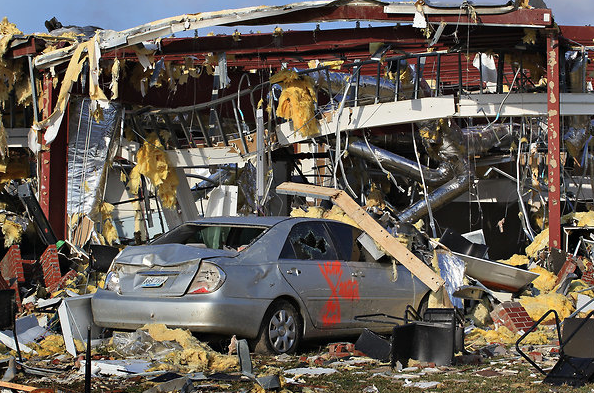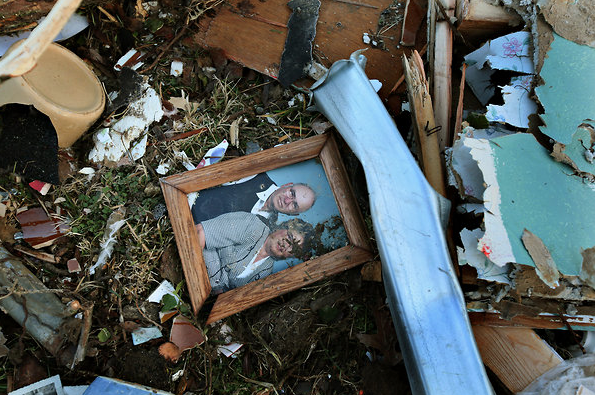It can be quite a revelation when the veneer of ordinary life is suddenly ripped away. Instead of the banal brick and mortar surfaces of a middle American high school, this:
Twisted metal, shredded drywall, crumpled ventilation ducts, broken cables–what was a solid, efficient building has become a rat’s nest of light industrial trash. That’s what a tornado can do.
The car that once was parked outside is now wearing the building, but it might be salvageable. Or the insurance company might just “write it off”–as if it could be moved out of there with a dash of a pen or a few keystrokes. But someone will have to lift that beam, just as others will have to move the chairs, the brickwork, the sheeting, and everything else that is strewn across the parking lot. And they’ll have to tear that shattered wall down and cart it away, and then begin to rebuild.
None of this work will involve standing in front of a TV camera or giving a campaign speech or writing a blog post. It’s called manual labor, something that has become all but invisible in a nation that carted up too many of its factories and shipped them overseas. Marx identified how capital benefits from hiding labor, but even he might be amazed at how much of modern culture has been pitched toward abstractions, sleek designs, smooth surfaces, frictionless interfaces, and other techniques for forgetting about the work involved in making a product.
Until the storm rips your world apart. When the surface is shredded, then you can see just how much structure there is in a building–that is, just how many different mechanical, electrical, and construction systems were artfully worked into a building, and how much workmanship goes into making use of the building so free of difficulty. You complain when the copier breaks–but how often does your ceiling collapse? Skilled labor and government regulation combine to make it easy to take gigantic skyscrapers for granted, as well as the many small structures and hundreds of thousands of products that we use everyday without ever having to make them or fix them ourselves.
Given this society’s investment in smooth surfaces, the texture of things all but completely hides the labor it took to make them. And that is part of a much larger indifference. A friend who consults on construction projects commented that it’s hard to generate public support for good wages for working people, “because it’s ingrained that labor isn’t respectable. Actually, it’s not disrespect….it’s less than that…….it’s non-recognition. Folks that don’t do labor don’t get just how thoroughly ignored labor is. You would be surprised by the number of people that, after having me carefully walk them through the steps of a complicated job, explain to me how ‘it shouldn’t be that hard.'” As if they would know. And all too often, they are the same people who expect “$125 per hour minimum to have a shot at a decent life, but can’t see why a mechanic would need the same amount.”
If you are skilled in abstraction, why would you know or care about how tough it can be to get a conduit to fit around a tight corner? But this discussion isn’t about the value of labor or the labor theory of value or anything more complicated than having a shot at a decent life.
Because that, too, is what the storm reveals when it tears through a town.
Photographs from Henryville, Indiana by Scott Olson/Getty Images.


[b]Welcome To The best Online (Articles|Discussion) Blog[/b]